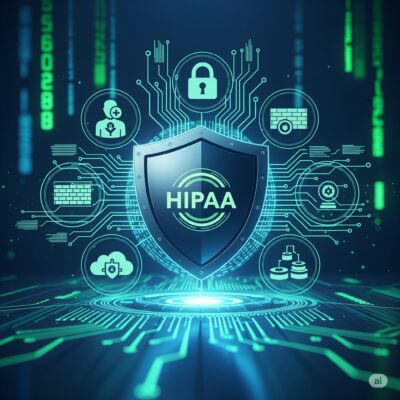The Health Insurance Portability and Accountability Act (HIPAA) Security Rule mandates that covered entities and their business associates establish and maintain robust safeguards to protect electronic Protected Health Information (ePHI). These safeguards are categorized into three main areas: Administrative, Physical, and Technical. A comprehensive set of policies is the foundation of a compliant security program.
Information (ePHI). These safeguards are categorized into three main areas: Administrative, Physical, and Technical. A comprehensive set of policies is the foundation of a compliant security program.
Here are 10 essential HIPAA security policies every covered entity must have, organized by their respective safeguard categories.
🔐 Administrative Safeguards
Administrative safeguards are the policies and procedures that manage security measures and the conduct of the workforce. They are the backbone of your HIPAA compliance program.
1. Risk Analysis and Management Policy
This is arguably the most crucial policy. It requires a covered entity to conduct a thorough and accurate risk assessment to identify potential threats and vulnerabilities to the confidentiality, integrity, and availability of ePHI. The policy must also outline a plan for implementing security measures to mitigate those risks to an appropriate level. This isn’t a one-time task; it should be an ongoing process with periodic reviews.
2. Security Incident Procedures Policy
Even with the best security, incidents can happen. This policy establishes a clear, step-by-step plan for responding to, reporting, and documenting security incidents. It should define what constitutes an incident (e.g., unauthorized access, data breach) and assign roles and responsibilities for containment, mitigation, and notification. A strong policy helps minimize the impact of a breach and ensures you meet all reporting requirements.
3. Assigned Security Responsibility Policy
To ensure accountability, this policy designates a Security Official to be responsible for developing and implementing the organization’s security policies and procedures. This individual or group oversees compliance efforts and acts as the central point of contact for all security-related matters.
4. Workforce Security Policy
This policy governs how a covered entity manages its workforce’s access to ePHI. It must include procedures for:
- Authorization and Supervision: Granting ePHI access based on a user’s role and job function (i.e., the “need-to-know” principle).
- Workforce Clearance Procedures: Establishing a process for background checks or other clearance methods for new employees before they are granted access.
- Termination Procedures: Promptly revoking all ePHI access for employees who leave or change roles.
5. Security Awareness and Training Policy
Human error is a leading cause of data breaches. This policy requires regular and mandatory security training for all workforce members. The training should cover the organization’s security policies, proper handling of ePHI, malicious software protection, password management, and how to report security incidents. It’s a continuous process, not a one-time event, with training reminders and updates as new threats emerge.
💻 Technical Safeguards
Technical safeguards are the technology and the policies for their use that protect ePHI and control access to it.
6. Access Control Policy
This policy outlines the technical measures used to control who can access ePHI. It’s built on the principle of least privilege, meaning users are only granted access to the information and systems absolutely necessary for their job. This policy should cover:
- Unique User Identification: Assigning a unique ID to each user to track their activity.
- Authentication: Procedures to verify a person or entity’s identity, such as using strong passwords or multi-factor authentication (MFA).
- Emergency Access Procedures: A plan for how to access ePHI during an emergency or disaster.
7. Transmission Security Policy
This policy protects ePHI when it is transmitted over an electronic network, such as over the internet or through email. It must include a mechanism to encrypt ePHI when deemed appropriate and to ensure the integrity of the data during transmission. Secure file transfer protocols and encrypted email services are common technical implementations of this policy.
🏢 Physical Safeguards
Physical safeguards are the physical measures, policies, and procedures to protect a covered entity’s electronic information systems and related buildings and equipment from unauthorized intrusion and environmental hazards.
8. Facility Access Controls Policy
This policy governs who has physical access to your facilities and the equipment that stores ePHI. It should include:
- Facility Security Plan: Measures to safeguard the facility from unauthorized physical access, tampering, and theft, such as alarms, security guards, and surveillance cameras.
- Access Control and Validation: Procedures to control and validate a person’s access based on their role, including visitor logs and escort policies.
9. Workstation Use and Security Policy
This policy sets rules for how workstations (computers, laptops, etc.) that access ePHI are used and secured. It should specify the physical location of workstations, prohibit unauthorized users from accessing them, and mandate security measures like automatic log-offs and password-protected screen savers.
10. Device and Media Controls Policy
This policy focuses on the proper handling and disposal of hardware and electronic media containing ePHI. It must include procedures for:
- Disposal: Securely disposing of ePHI on hardware and electronic media to prevent data recovery (e.g., physically destroying hard drives).
- Media Re-use: Procedures for removing ePHI from electronic media before it is re-used.
- Accountability: A record of the movement of hardware and electronic media.
Why Are These Policies So Important?
These policies are not just a checklist; they are the core of a strong and defensible security program. They serve as a roadmap for your entire organization, outlining everyone’s responsibilities in protecting patient data. By implementing and regularly reviewing these 10 essential policies, covered entities can significantly reduce their risk of data breaches, avoid costly penalties, and, most importantly, build trust with their patients by demonstrating a commitment to safeguarding their sensitive information.
